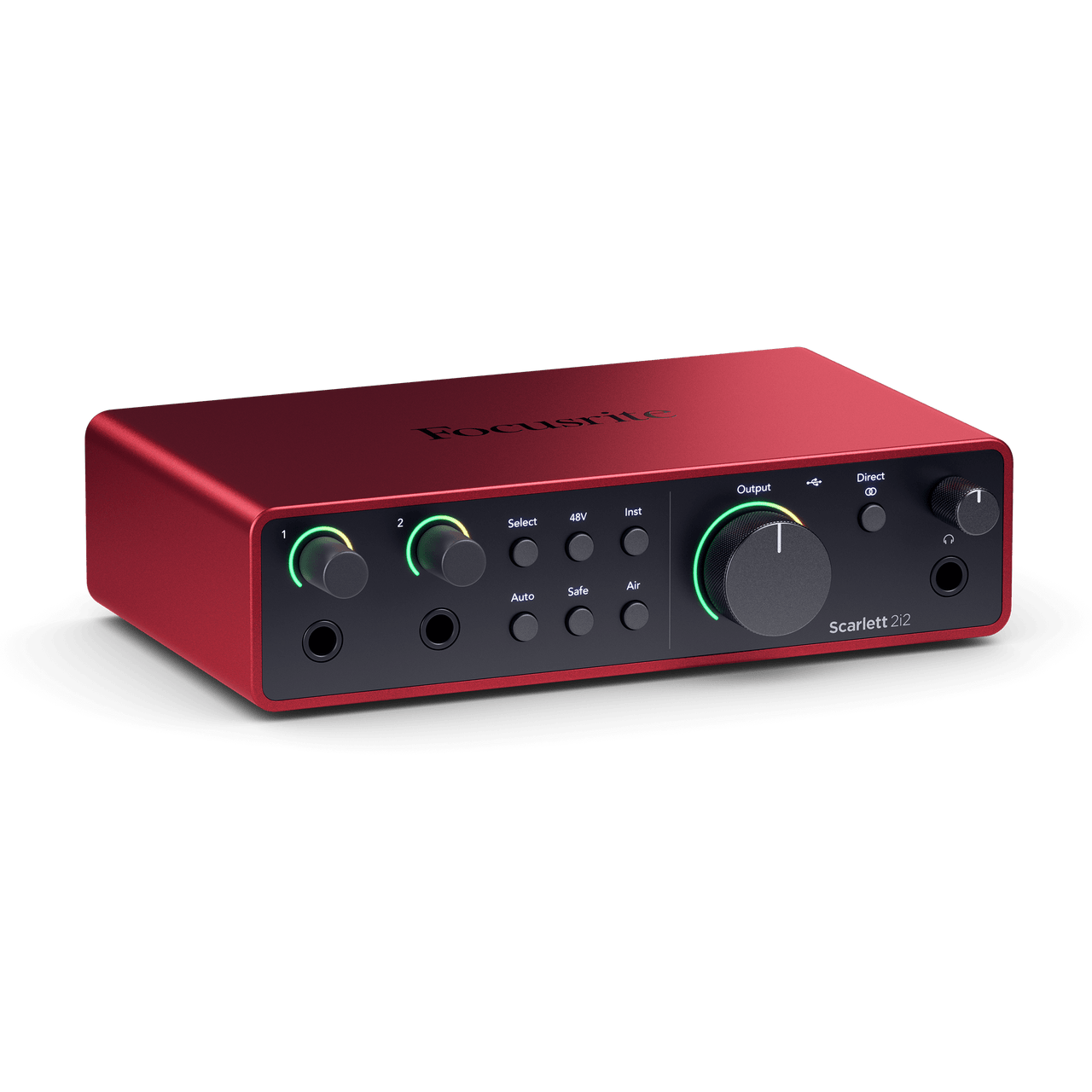If you’ve spent any time in the home-studio world, you already know the Focusrite Scarlett 2i2 — one of the most popular audio interfaces ever made.
The new 4th-gen model takes that legacy and refines it: you still get the clean sound, plug-and-play setup, and rock-solid drivers producers rely on, but now with modern upgrades like Auto Gain, Clip Safe, and Loopback.
It’s a trusted workhorse that feels even more polished, letting you focus on capturing great performances instead of troubleshooting gear.
⭐️⭐️⭐️⭐️☆ (9.0/10) • Approx. $219.99

Sound Quality
The Focusrite Scarlett 2i2 delivers transparent, low-noise conversion up to 24-bit/192kHz. The updated preamps are clean and quiet, and the Air option adds a subtle, mix-friendly presence lift.
There’s enough gain for most mics; for very gain-hungry dynamics (think broadcast mics), an inline booster can still help.
Monitoring is clear and latency is comfortably low for tracking vocals, guitars, and soft synths.
Build & Design
Signature red aluminum shell, solid knobs, and a tidy desktop footprint. You get separate Monitor and Headphone level controls, clear front-panel meters/indicators, and a straightforward layout that makes everyday use painless.
It’s bus-powered over USB-C, so it travels well and keeps cable clutter down.
Features
- 2 combo XLR/TRS inputs with 48V phantom power
- 24-bit/192kHz AD/DA conversion
- Auto Gain to set input levels automatically
- Clip Safe to prevent ruined takes from unexpected peaks
- Air mode for a touch of high-end presence
- Loopback (virtual inputs) for streaming, sampling, and tutorials
- Direct Monitor for zero-distraction tracking
- USB-C, bus-powered with low-latency drivers
- Software bundle with useful instruments/effects to get started
Price & Value
The Focusrite Scarlett 2i2 (4th Gen) typically retails around $179–$199, keeping it firmly in the affordable category for beginner and intermediate producers.
Despite the low price point, it delivers reliable preamps, improved converters, and a sturdy build that outshine many competitors in the same range.
Competing with interfaces like the MOTU M2 and PreSonus AudioBox USB, the Scarlett 2i2 continues to stand out as the industry’s go-to starter interface.
Its mix of ease of use, professional sound quality, and long-term durability makes it one of the best value purchases for anyone setting up a home studio.
Pros
- Clean, reliable sound with improved 4th-gen preamps
- Auto Gain + Clip Safe = stress-free recording
- Loopback makes streaming and content capture easy
- Rock-solid drivers; simple setup on Mac/PC
- Great value for first—and second—studios
Cons
- Only 2 inputs; no built-in MIDI I/O
- Some advanced features live in the software app
- Very gain-hungry dynamics may still want an inline booster
- Single headphone output
Verdict
The Scarlett 2i2 (4th Gen) nails the home-studio brief: clean sound, smart safety features, and plug-and-play reliability.
If you want an interface that quietly does its job day after day—and helps you avoid retakes—the 2i2 remains an easy recommendation.
Rating: 9.0/10 — A dependable, modern classic for home studios.
FAQ
Is the Focusrite Scarlett 2i2 good for beginners?
Yes — it’s one of the most popular entry-level interfaces thanks to its ease of use, great sound quality, and bundled software package.
What’s new in the 4th Gen Scarlett 2i2 compared to previous versions?
The 4th Gen features upgraded preamps with more gain, improved converters, an Air mode for added clarity, and a refreshed design with better metering.
Does the Scarlett 2i2 need drivers to work?
On Mac, it works as a class-compliant device with no extra drivers needed. On Windows, installing Focusrite Control is recommended for best performance and access to all features.
Can the Scarlett 2i2 power studio monitors?
Yes — it has balanced line outputs for connecting directly to powered monitors.
Does the Scarlett 2i2 provide phantom power for condenser microphones?
Yes — it supplies +48V phantom power, so you can use condenser mics like the AT2020 or Rode NT1.
Is the Scarlett 2i2 durable for long-term use?
Yes — it’s built with a sturdy metal chassis and is widely regarded as reliable for both home studios and mobile setups.
Looking for more options? Return to our Audio Interfaces Reviews Hub

Leave a Reply